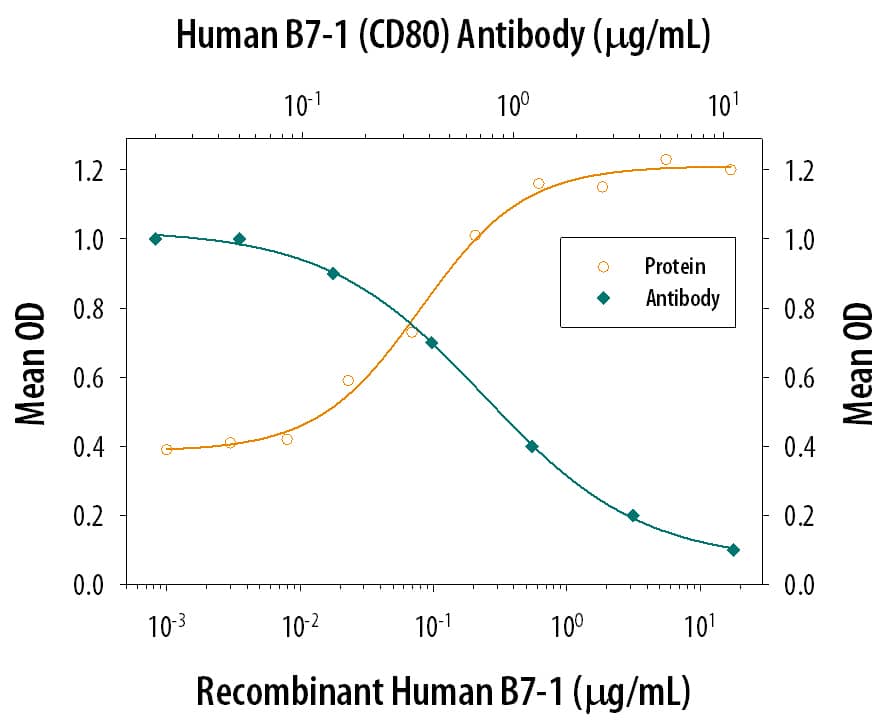Human B7-1/CD80 Antibody Best Seller
R&D Systems, part of Bio-Techne | Catalog # MAB140


Key Product Details
Validated by
Species Reactivity
Validated:
Cited:
Applications
Validated:
Cited:
Label
Antibody Source
Product Specifications
Immunogen
Val35-Asn242 (predicted)
Accession # P33681
Specificity
Clonality
Host
Isotype
Endotoxin Level
Scientific Data Images for Human B7-1/CD80 Antibody
Detection of B7-1/CD80 in Raji Human Cell Line by Flow Cytometry.
Raji human Burkitt's lymphoma cell line was stained with Mouse Anti-Human B7-1/CD80 Monoclonal Antibody (Catalog # MAB140, filled histogram) or isotype control antibody (Catalog # MAB002, open histogram), followed by Fluorescein-conjugated Anti-Mouse IgG Secondary Antibody (Catalog # F0103B). View our protocol for Staining Membrane-associated Proteins.IL‑2 secretion Induced by B7‑1/CD80 and Neutralization by Human B7‑1/CD80 Antibody.
Recombinant Human B7-1/CD80 Fc Chimera (Catalog # 140-B1) co-stimulates IL-2 secretion in the Jurkat human acute T cell leukemia cell line in the presence of PHA in a dose-dependent manner (orange line), as measured by the Human IL-2 Quantikine ELISA Kit (Catalog # D2050). IL-2 secretion elicited by Recombinant Human B7-1/CD80 Fc Chimera (1 µg/mL) and PHA (10 µg/mL) is neutralized (green line) by increasing concentrations of Mouse Anti-Human B7-1/CD80 Monoclonal Antibody (Catalog # MAB140). The ND50 is typically 0.2-1 µg/mL.B7‑1/CD80 in Human Tonsil.
B7-1/CD80 was detected in immersion fixed paraffin-embedded sections of human tonsil using Mouse Anti-Human B7-1/CD80 Monoclonal Antibody (Catalog # MAB140) at 5 µg/mL overnight at 4 °C. Tissue was stained using the Anti-Mouse HRP-DAB Cell & Tissue Staining Kit (brown; Catalog # CTS002) and counterstained with hematoxylin (blue). Specific staining was localized to cytoplasm in lymphocytes. View our protocol for Chromogenic IHC Staining of Paraffin-embedded Tissue Sections.Applications for Human B7-1/CD80 Antibody
CyTOF-ready
Dual RNAscope ISH-IHC Compatible
Sample: Immersion fixed paraffin-embedded sections of human tonsil tissue
Flow Cytometry
Sample: Raji human Burkitt's lymphoma cell line
Immunohistochemistry
Sample: Immersion fixed paraffin-embedded sections of human tonsil tissue
Neutralization
Human B7-1/CD80 Sandwich Immunoassay
Use in combination with these reagents:
- Detection Reagent: Human B7-1/CD80 Biotinylated Antibody (Catalog # BAM1402)
- Standard: Recombinant Human B7-1/CD80 Fc Chimera His-tag Protein, CF (Catalog # 140-B1)
Reviewed Applications
Read 2 reviews rated 3.5 using MAB140 in the following applications:
Formulation, Preparation, and Storage
Purification
Reconstitution
Formulation
Shipping
Stability & Storage
- 12 months from date of receipt, -20 to -70 °C as supplied.
- 1 month, 2 to 8 °C under sterile conditions after reconstitution.
- 6 months, -20 to -70 °C under sterile conditions after reconstitution.
Background: B7-1/CD80
B7-1 and B7-2, together with their receptors CD28 and CTLA-4, constitute one of the dominant co-stimulatory pathways that regulate T- and B-cell responses. Although both CTLA-4 and CD28 can bind to the same ligands, CTLA-4 binds to B7-1 and B7-2 with a 20‑100 fold higher affinity than CD28 and is involved in the down‑regulation of the immune response. B7-1 is expressed on activated B cells, activated T cells, and macrophages. B7-2 is constitutively expressed on interdigitating dendritic cells, Langerhans cells, peripheral blood dendritic cells, memory B cells, and germinal center B cells. Additionally, B7-2 is expressed at low levels on monocytes and can be up‑regulated through Interferon gamma. B7-1 and B7-2 are both members of the Immunoglobulin superfamily. Human B7-1 is a 288 amino acid (aa) protein containing a 34 aa signal peptide, a 208 aa extracellular domain, a 21 aa transmembrane domain, and a 25 aa cytoplasmic domain. Human B7-1 and B7-2 share 26% aa sequenceidentity. Human and mouse B7-1 share 44% aa sequenceidentity. However, it has been observed that both human and mouse B7-1 and B7-2 can bind to either human or mouse CD28 and CTLA-4, suggesting that there are conserved amino acids which form the B7-1/B7-2/CD28/CTLA-4 critical binding sites.
References
- Azuma, M. et al. (1993) Nature 366:76.
- Freeman, G.J. et al. (1993) Science 262:909.
- Freeman, G. et al. (1991) J. Exp. Med. 174:625.
- Selvakumar, A. et al. (1993) Immunogenetics 38:292.
- Chen, C. et al. (1994) J. Immunol. 152:4929.
- Freeman, G.J. et al. (1993) J. Exp. Med. 178:2185.
Alternate Names
Gene Symbol
UniProt
Additional B7-1/CD80 Products
Product Documents for Human B7-1/CD80 Antibody
Product Specific Notices for Human B7-1/CD80 Antibody
For research use only



